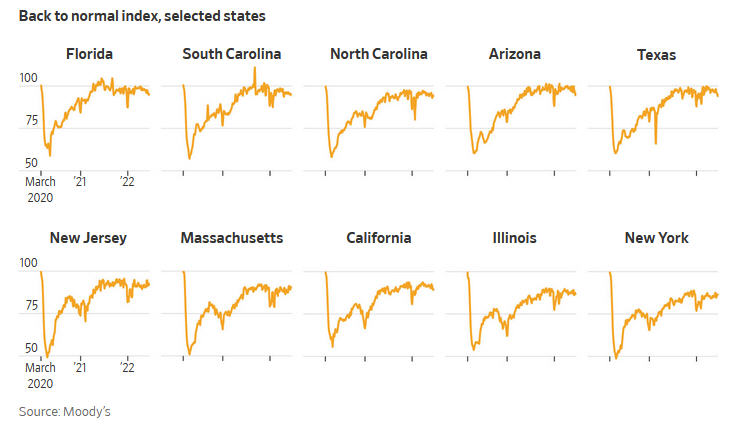On of the principles in the founding of America was that each state would be run individually and become a laboratory for new ideas. If a state had policies that were succeeding, other states would then be free to copy the ideas that worked. However, we are not necessarily seeing that concept currently put in practice. If it were, California would be copying the policies of Florida rather than trashing the Governor of Florida.
On July 5th, The Wall Street Journal posted an article illustrating the contrast in the economic conditions of blue and red states.
The article reports:
The pandemic has changed the geography of the American economy.
By many measures, red states—those that lean Republican—have recovered faster economically than Democratic-leaning blue ones, with workers and employers moving from the coasts to the middle of the country and Florida.
Since February 2020, the month before the pandemic began, the share of all U.S. jobs located in red states has grown by more than half a percentage point, according to an analysis of Labor Department data by the Brookings Institution think tank. Red states have added 341,000 jobs over that time, while blue states were still short 1.3 million jobs as of May.
Several major companies have recently announced moves of their headquarters from blue to red states. Hedge-fund company Citadel said recently it would move its headquarters from Chicago to Miami, and Caterpillar Inc. plans to move from Illinois to Texas.
The article includes the following:
Pandemic Recovery
The economic recovery of states since March 2020 has been uneven. Index of state progress, based on 13 metrics including economic output, employment, retail sales and new-home listings.
 Please follow the link above to read the entire article. It is fascinating.
Please follow the link above to read the entire article. It is fascinating.
The article concludes:
California’s public-school enrollment has fallen 4.4% since the pandemic, according to American Enterprise Institute. In Oakland, the school board recently voted to close schools because of declining enrollment.
Florida saw a surge in new residents, many from the Northeast, where Covid-19 related restrictions such as school closures were stricter.
At the Ohana Institute, a private school in Florida’s Panhandle, for kindergarten through 12th grade, the waiting list for students grew from 95 just before the pandemic to 393 last fall, Executive Director Lettye Burgtorf said.
Mrs. Burgtorf said the school fielded requests from hundreds of parents around the U.S. who wanted to move to Florida to be closer to the beach. Many were also unhappy that their children’s schools in other states had moved to remote learning. The Ohana Institute went remote for several weeks, then reopened, with mask mandates. “The parents were really like, ‘We cannot educate our kids at home,’ ” Mrs. Burgtorf said.
For years, a real estate boom in coastal cities made many families wealthy because their homes appreciated. Now, that is happening in red states. Florida led all states with a 31% jump in the median home price in the 12 months through January, with prices soaring in the Panhandle.
Such price increases can narrow the cost-of-living differential with the blue states that the migrants are fleeing, and increase living costs for longtime residents who don’t own homes,
These days, Mr. DeSantis’s spokeswoman said, one of the top complaints the governor’s office receives is soaring rent.
The law of supply and demand is at work in the Florida housing market.
